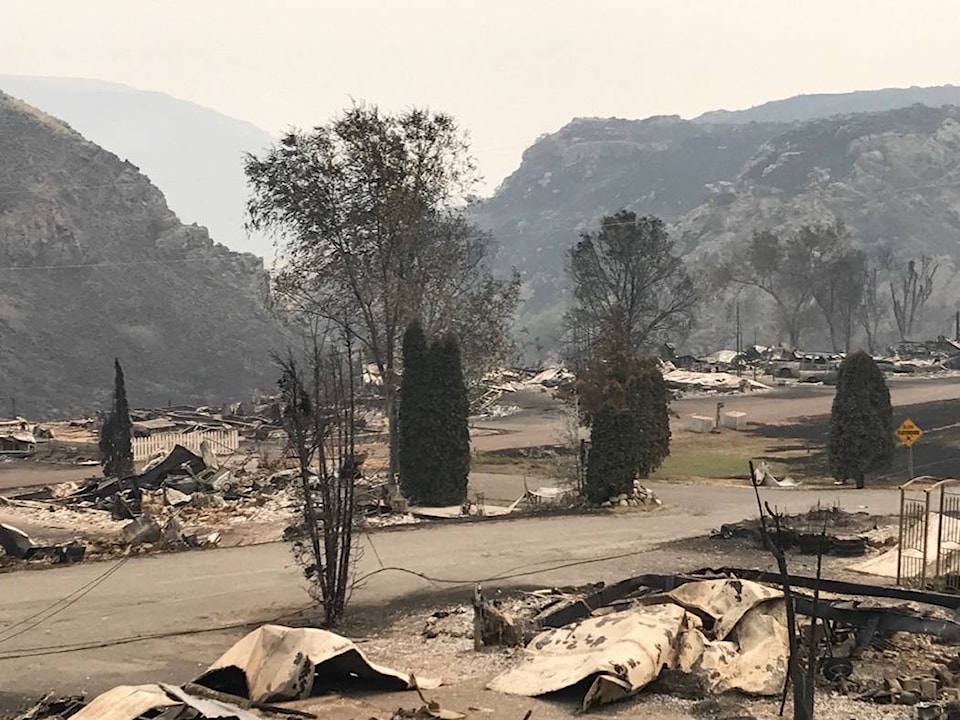The Elephant Hill wildfire has stayed stable at 192,725 hectares, and as of Sept. 19 was 85 per cent contained, according to the BC Wildfire Service.
Approximately 418 personnel are still attached to the fire, with crews continuing to make good progress, especially with the recent cooler and wetter conditions.
Crews continue to assess danger trees in areas affected by the fire. Many trees have been damaged and/or had their roots weakened during the fire, making them very susceptible to toppling over in the event of wind. Residents in areas where crews are working are urged to drive with caution, to be conscious of the danger posed by these trees, and not to enter any burned areas.
On Sept. 12, the Thompson-Nicola Regional District, inclusive of the Village of Cache Creek, issued a summary of known structure loss and damage suffered over the last two months due to the Elephant Hill, Little Fort Complex, and Martin Mountain wildfires.
Overall, a total of 234 structures were lost or damaged. Of this number, 215 structures were completely destroyed and 19 suffered minor damage. In total, 228 of the destroyed and damaged structures were from the Elephant Hill fire.
The areas hardest hit by the Elephant Hill wildfire were Boston Flats (45 residences lost); the Loon Lake community (40 residences and 33 other structures lost), and the Pressy Lake area, where 33 residences and 24 other structures were destroyed.
For areas of significant property damage — such as Boston Flats, Loon Lake, and Pressy Lake — the TNRD was able to arrange for drone footage to be taken to provide owners with an aerial view of the damage caused by the fire. The report noted that the property damage and loss was not inclusive of all of the damage that was suffered throughout the region to important infrastructure, such as hydro and telecommunications.
It also pointed out the importance of the Civic Addressing program that the TNRD announced earlier this year. If, during a wildfire event, there is structure loss or damage reported to the TNRD, it will initiate contact with the property owner. In rural areas within the TNRD, not all owners have registered their civic address with the TNRD, nor have they posted their addresses at their properties, so it can on occasion take some investigation to identify the specific property address.
On September 13 the area restriction around the Elephant Hill wildfire was modified. This area restriction will remain in place until noon on October 31, 2017 or until the public is otherwise notified. The modified area restriction is in place to help protect public safety and to ensure the safety of firefighting personnel. The area restriction order applies to all Crown land within the geographic boundaries shown on the map posted online at http://ow.ly/llPC30f8qnc.
The Evacuation Orders orders for Hihium Lake, Young Lake, Pressy Lake, and Little Pressy Lake were changed to Evacuation Alerts as of 2 p.m. on September 16. A re-entry meeting was held in 70 Mile earlier in the day, to provide information to returning residents. The Hihium Lake area had been under Evacuation Order since July 8.
On September 17, the TNRD announced that all remaining Evacuation Orders in the district were being downgraded to Evacuation Alerts effective immediately, meaning that for the first time since July 7, there are no Evacuation Orders within the Thompson-Nicola Regional District.
The provincial state of emergency that was first announced on July 7, and extended four times since that date, expired at midnight on Friday, September 15. However, the Province will continue to take every action necessary to respond to the ongoing wildfire situation and support the recovery of affected communities, and is already implementing a long-term plan to recover from this year’s wildfires.
The Ministry of Forests, Lands, Natural Resource Operations and Rural Development has assumed leadership from Emergency Management BC for the government’s long-term wildfire recovery efforts. Regional economic officers based in communities that include Kamloops and Quesnel are working closely with communities affected by wildfires in the Cariboo, Thompson, and Kootenay regionsMinistry of Forests staff are working with the forestry sector and issuing salvage licences and expediting cutting permits to help people in the industry get back to work as quickly as possible. They are also assessing the impacts of this year’s fires on the timber supply and prioritizing areas for reforestation.
The provincial and federal governments have committed $20 million to agricultural producers, in addition to the $6 million that the Province is already spending to replace damaged fencing along highways and on Crown rangeland. An estimated 450 kilometres of fencing on Crown land has been damaged or destroyed by fire this year. Support for ranchers includes assistance with the relocation of livestock, emergency feed supplies, replacement of breeding stock, reseeding of rangeland, and arranging for alternative grazing areas.
editorial@accjournal.ca
Like us on Facebook and follow us on Twitter
